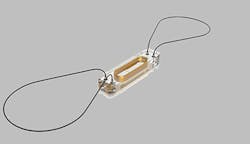A Dime-Sized Heart Sensor Helps Detect Heart Failure
At Mount Sinai hospital in New York, cardiologists have started using microchip sensors in patients with advanced heart failure to monitor their symptoms and help reduce their chances of return visits to the hospital.
The sensor, CardioMEMS HF System, was developed by St. Jude Medical center. The sensor does not require a battery and can be implanted directly into the heart to monitor the pulmonary artery. It is about the size of a dime and is placed inside the heart via a minimally invasive procedure. The miniaturized wireless sensor can be implanted using a catheter-based procedure. The procedure itself is about an hour long and requires no overnight stay. Patients can resume daily activity as the sensor goes unnoticed within the patient’s heart.
The sensor detects increases of pressure in the pulmonary artery. The rise in pressure is a preliminary sign of heart failure that can be detected prior to symptoms presenting themselves, such as shortness of breath, requiring immediate medical care. The sensor is hermetically sealed and contains an inductor coil and pressure-sensitive capacitor. The inductor coil and capacitor create a resonant circuit at a specific frequency. The blood pressure affects the resonant frequency and as blood pressure changes so does the resonant frequency. The external measurement system tracks the resonant frequency wirelessly and determines the pressure in the pulmonary artery.
Watch "Dime-Sized CardioMEMS Sensor Detects Early Signs of Heart Failure", courtesy of Engineering TV, below:
The sensor also has the capability to provide these pressure readings daily. The medical team can then use this data to provide proactive real-time care to help personalize treatment and reduce worsening conditions. Clinical trials have shown that hospital readmissions for advanced heart failure lowered by 37% with patients using the CardioMEMS sensor.
Hospital readmissions due to heart failure are a growing trend among heart failure patients. Mount Sinai’s goal is to improve the quality of life in their patients and stabilize their condition to help reduce readmissions. This will benefit Medicare and Medicaid Services since the trend of readmitting heart failure patients is increasing health-care costs. The sensor is being implanted in patients that have been hospitalized in the last 12 months.
The CardioMEMS sensor is unique and was given approval by the FDA in 2014. The clinical research has shown that the sensor can be a reliable source of data. According to Raymond Bietry, M.D., the “new device will enable heart failure patients to live more comfortably, easing their worries as we closely monitor them for the earliest signs of fluid retention, a major cause of the symptoms of breathlessness and tiredness heart failure patients experience.” Bietry is an assistant professor of cardiology and was the first cardiologist at Mount Sinai to implant the device.
